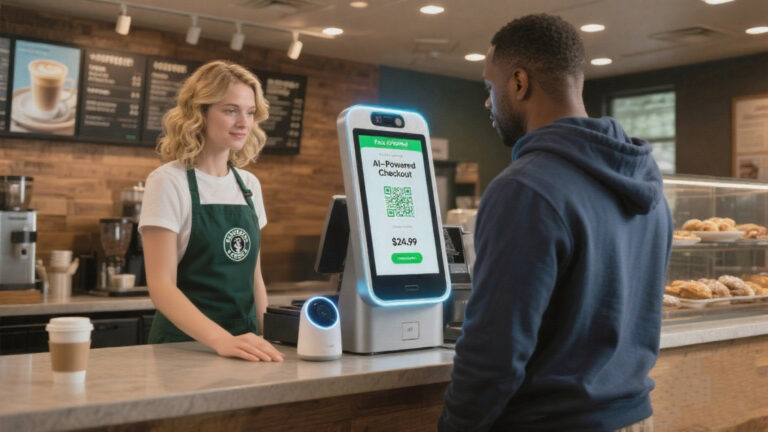Table of Contents
The rapid advancement of large language models (LLMs) and AI agent platforms is beginning to reshape entire industries. SaaS startups are rushing to launch AI-driven platforms that promise to automate workflows, personalize customer experiences, and reduce operational costs. For the restaurant POS industry, this wave of innovation raises urgent questions:
- Will AI replace traditional POS software?
- Which parts of the restaurant operation will AI disrupt first?
- How should POS ISVs and ISOs prepare to survive—and thrive—in this transition?
As a POS software ISV operating in the U.S. market, I want to share a forward-looking perspective on how AI will affect our industry over the next 5–10 years, and what steps stakeholders should take to stay competitive.
1. Will AI Replace POS Software?
Let’s address the elephant in the room. POS software is the digital backbone of restaurants: it manages orders, payments, inventory, menus, staff, and reporting. Could AI simply replace all of this?
The short answer: no, at least not in the foreseeable future. Restaurants need structured, compliant, and transactionally secure systems. Payment acceptance, tax compliance, cash drawer integration, and PCI regulations are non-negotiable. AI agents can’t “wing it” with payments or rely on probabilistic outputs when money is involved. The POS remains a system of record—a role that AI cannot fully replace.
However, AI will become a layer on top of POS, enhancing it in ways that traditional systems can’t. The future is not about AI replacing POS, but AI-infused POS replacing non-AI competitors.
2. Where AI Will Transform POS in Restaurants
Over the next decade, AI will integrate into POS across multiple layers:
Front-of-House Experience
- Voice Ordering & Conversational Interfaces: Guests will increasingly order via AI voice kiosks, drive-thru assistants, or smart speakers. Instead of rigid menu screens, customers will say: “I’d like a burger without pickles, add extra cheese, and make it a combo.” AI will translate this into structured POS orders instantly.
- Smart Recommendations: AI will upsell and cross-sell better than static prompts. A returning customer might hear: “Last time you ordered a spicy chicken sandwich—do you want to try our new spicy fries with it?”
Back-of-House Operations
- Inventory Forecasting: Instead of manual reordering, AI will predict demand based on sales history, seasonality, and even local events. A POS with AI could alert: “You’ll run out of avocados by 6 PM tomorrow—place an order now.”
- Staff Scheduling: AI can forecast peak hours and suggest optimized schedules, cutting labor costs and preventing overstaffing.
Customer Engagement
- AI-Powered Loyalty: Today’s loyalty programs are rule-based. Tomorrow’s will be dynamic, with AI tailoring offers to individual behavior: “John usually orders a latte on Fridays—send him a 2-for-1 offer this morning.”
- Personalized Marketing: Integration with online ordering and social data will let AI recommend campaigns that feel natural and human, not spammy.
Owner/Manager Insights
- AI-Driven Dashboards: Instead of static reports, managers will interact with AI copilots: “How did last week’s happy hour affect beer sales?” or “Which menu items should I discontinue to boost profitability?”
- Scenario Simulation: AI will model outcomes—if prices rise 5%, how will that impact sales and profit margins?
3. Why AI Won’t Be Plug-and-Play in Restaurants
It’s important to recognize that restaurants are complex, real-world businesses. Unlike pure digital products, food service involves perishable goods, human staff, and unpredictable customers. AI must be carefully integrated to avoid disruption.
- Accuracy Matters: A chatbot that suggests the wrong menu item is inconvenient. A POS that charges the wrong tax rate or mishandles payments is catastrophic.
- Regulation: PCI compliance, state-level surcharging laws, and labor laws aren’t negotiable. AI tools must be embedded into compliant POS platforms.
- Human Factor: Many restaurant owners are not tech-savvy. AI adoption must be seamless, intuitive, and trustworthy.
This means ISVs remain the gatekeepers: AI is powerful, but it needs a structured POS foundation to actually deliver value at scale.
4. The Role of ISVs in an AI Future
For ISVs, the rise of AI is both a threat and an opportunity. The threat comes from new entrants—AI-first SaaS startups that may bypass traditional POS and promise restaurants a “fully automated operating system.” The opportunity comes from embedding AI into existing POS ecosystems in a way startups cannot match.
Here’s what ISVs should do:
- Adopt AI Early: Don’t wait until competitors roll out AI-powered POS features. Voice ordering, AI chat-based dashboards, and predictive analytics should already be on your roadmap.
- Focus on Vertical AI: Generic AI is not enough. A restaurant-specific AI trained on menus, ingredients, order patterns, and compliance rules will win.
- Open Integrations: Partner with AI startups rather than compete head-to-head. Build APIs so AI tools can sit on top of your POS safely.
- Human-AI Balance: Remember, restaurants are about hospitality. AI should empower staff, not replace them. Position your AI features as assistants, not overlords.

5. The ISO Perspective: How Resellers Should Adapt
Independent Sales Organizations (ISOs) face their own challenges. If ISVs move toward AI-driven POS, ISOs can’t just sell “boxes and terminals” anymore. They must sell intelligence.
Key steps for ISOs:
- Educate Merchants: Many restaurant owners are curious about AI but don’t know where to start. ISOs can win trust by being educators, not just salespeople.
- Sell Value, Not Hardware: The winning pitch shifts from “This terminal runs fast” to “This system saves you 20 hours a week in staffing and increases average ticket size by 12%.”
- Upsell AI Features: Dual pricing helped ISOs increase revenue by eliminating card fees. Similarly, AI-driven add-ons—smart marketing, AI reporting, labor optimization—become new profit centers.
- Stay Ahead of Compliance: AI brings complexity, but merchants still rely on ISOs for clarity. Helping restaurants navigate laws around pricing, surcharging, and data privacy will become even more important.
6. The Next 5–10 Years: A Roadmap
If we look ahead, here’s how the adoption curve may unfold:
- Years 1–3: Early adoption of voice ordering, AI dashboards, and loyalty personalization. Mostly optional features.
- Years 3–5: AI becomes a competitive necessity. Restaurants not using AI insights will fall behind in labor costs, customer engagement, and efficiency.
- Years 5–10: AI is fully embedded into POS ecosystems. The distinction between “POS software” and “AI platform” disappears—just as the line between “cash register” and “POS” disappeared decades ago.
Conclusion: The Human-Centered AI POS
The future of restaurant POS is not about machines taking over—it’s about AI enabling restaurants to do what they do best: serve guests, create experiences, and run profitably. POS software will remain the backbone, but AI will become the nervous system that brings intelligence to every transaction, every decision, and every customer interaction.
For ISVs, this is a moment to lead, not lag. For ISOs, it’s a chance to evolve from payment resellers into business growth consultants. Those who embrace AI early will not only survive the coming disruption but define the next era of restaurant technology.
The AI wave is coming. The question is not whether POS will be replaced, but whether your POS will be ready.


